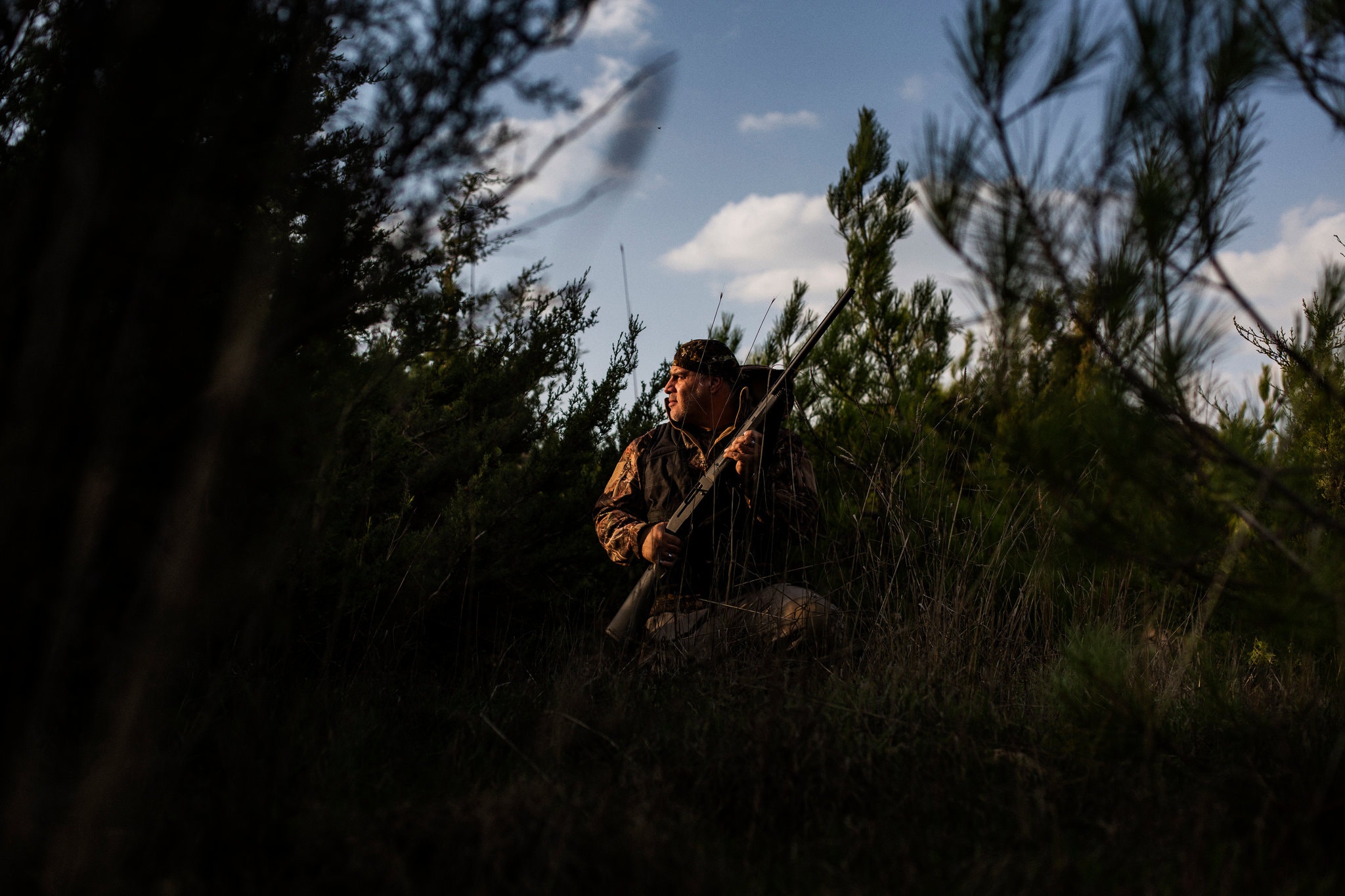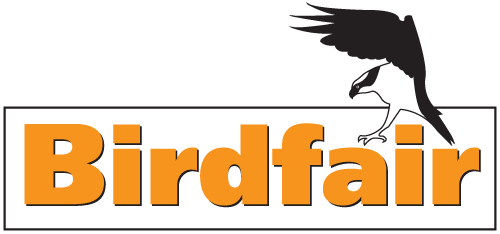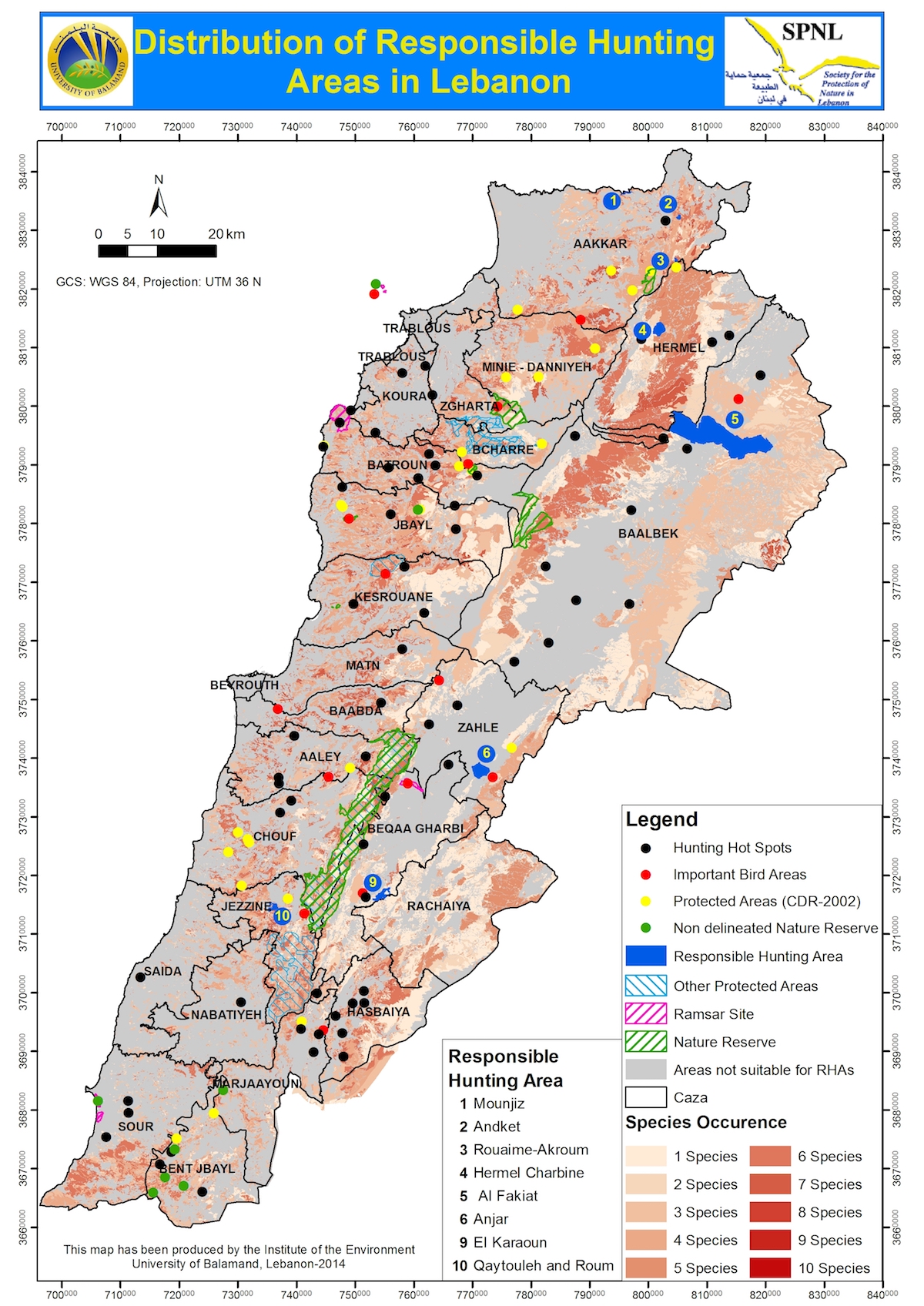
Responsible Hunting Programme
Responsible Hunting Programme

THANKS TO THE SUPPORT OF
Lebanon lies on the west side of the Rift valley African Eurasian flyway, which is considered one of the most important flyways for bird migration in the world. In spite of its small geographical area, at least 399 species of birds have been recorded in Lebanon. The wealth and diversity in bird species increases the assets of the country, but on the other hand amplifies our collective responsibility for their conservation.
SPNL has been working on the hunting issue since its establishment in 1984. One of its fundamental aims is to help in hunting management in Lebanon while the other aim is to promote protected areas.
SPNL has been involved with BirdLife International in the regional project “Building Capacity for Sustainable hunting of Migratory Birds in Mediterranean Third Countries of North Africa and the Middle East-SHP” from 2004 – 2007 funded by the European Union (EU), where Lebanon was the hub for the West Asia countries. The main achievements in Lebanon were data collection through a national opinion poll, elaboration of the draft legal decrees and decisions for the new hunting law in Lebanon (Law No. 580/2004). In addition, SPNL played an important role in organizing training workshops for law enforcement officers on bird identification, conservation and legal issues, as well as capacity building on conflict resolution skills involving stakeholders of the hunting sector in Lebanon. Moreover, SPNL produced awareness material targeting mainly hunters on globally threatened and game bird species, a bird field guide in Arabic, and an educational manual for school children. On a regional level, the project produced synthesis reports on status of hunting, guidelines for hunting management for governments, and code of practice manual for hunters, thus providing the basis for a ‘model‘ of sustainable approach to birds hunting.
SPNL has also been involved with the UNDP project “Mainstreaming Conservation of Migratory Soaring Birds into Key Productive Sectors along the Rift Valley/Red Sea Flyway” from 2010 – 2015 funded by Global Environment Fund (GEF). Main achievements of the Project were:
- Representing the conservation NGOs in the Hunting Higher Council for 2 terms.
- Reports on linkage between hunting and livelihood, relation between hunting and soaring birds, sub-threats for hunting including mitigation measures,
- GIS maps for distribution of soaring birds; Map identifying location of bottlenecks, IBAs/PAs, hunting reserves (public and private), and hunting clubs; and Map of “threat hotspots” for hunting.
- Development of several awareness materials, namely: Soaring birds atlas, Field Guide to the Soaring Birds of Lebanon, Manual for Bird Identification Training, Guide for the hunting exam and its relevant questions and answers,
- Training Educational Coordinators from the Ministry of Education on the use of the Educational Manual/CD.
- Trainings for law enforcement officers and hunting clubs, mainly on bird identification and hunting law.
- Production of a business plan for responsible hunting management in Lebanon;
- Report on existing shooting clubs, private hunting reserves, game bird breeding farm, existing protected classified sites, and potential public & private hunting areas;
- Report about national policies, legislation related to hunting in Lebanon highlighting identified gaps in policies & legislations, and suggesting relevant recommendations;
- Report about local case study for implementation of the hunting application decrees and decisions at one pilot site;
- Technical support for the development of draft application decisions and decrees of the hunting law.

Currently, SPNL is promoting responsible hunting areas-RHAs concept that would support conservation efforts & proper law enforcement. Thus, hunting can be practiced responsibly under the supervision of municipalities, within the law regulations in restricted areas. SPNL has worked to set the criteria for responsible hunting areas (RHAs) in Lebanon. The RHAs should primarily be evenly distributed over the seven Mohafazats (large administrative districts) of Lebanon established over communal land and/or on governmental property. The RHAs should also preferably be able to host/provide habitat for at least 3 – 4 out of the 16 game bird species. Within the MSB project – stage I, and in collaboration with ministry of Environment and UNDP, SPNL was able to identify 8 RHAs on municipal land, and to declare them as Himas for responsible hunting by the relevant municipal councils (Map of identified RHAs in Lebanon).
SPNL was awarded «Birdlife International Partnership Award» in 2013 for its work on promoting responsible hunting.
SPNL continued to reinforce its efforts of spreading awareness on the concept of responsible hunting by believing that awareness needs to be improved, collectively, as hunting is a shared responsibility of the country. In order to increase the spread of awareness among the Lebanese community, SPNL is reaching out to people on social media, on radios, TV programs and of course in all of the Hima sites through the following projects:
“Capacity Development for Flyway Conservation in the Mediterranean” (stage I & II) Project:
1 September 2012 – 31 August 2014 and 1 February 2015 – 31 January 2017
- Development of training program for hunters based on the “Hunter Guide” (in order to enable them to pass the hunting exam for the license).
- Development of an online quiz as a trial for the hunter before the actual exam (based on the Questions & Answers developed).
- Launching of an Arabic Interactive Website addressed mainly to hunters.
- Social media addressing hunters.
- Establishment of «West Bekaa Centre for Responsible hunting».
- Signature of declaration on responsible hunting by a group of professional hunters.
- Development of software for a competition between hunters on the correct bird identification skills, based on color, flight, movement,….
“Promoting responsible hunting practices in Lebanon using community based approach” Project
1 January 2014 – 30 September 2015, funded by CEPF
- Development of awareness material addressed to LEF conservation NGOs
- website on responsible hunting www.responsiblehunting.org
- Short film on status of hunting in Lebanon
- Four posters on game species; permits, safety measures; RHA concept
- Awareness leaflet covering the above 4 themes
- Mobile app addressing conservation NGOs for Apple and Android users
Apple: https://itunes.apple.com/lb/app/responsible-hunting/id1032369115?mt=8
Android: https://play.google.com/store/apps/details?id=com.omar.lef&hl=en
- Initiation of studies for 1st model RHA (EIA, management and monitoring plan, business plan….)
“Hope for migratory birds in Eastern Mediterranean: action against illegal killing of Birds” Project:
1 January 2016 – 31 December 2018, funded by BirdFair
- Raising awareness and increasing the understanding of new hunting laws and regulations by relying on social media: websites, leaflets and posters, press/radio/TV coverage
- Building alliances for responsible hunting, including monitoring and reporting on persecution activities within residential areas and blackspots
- Encouraging hunters to take initiatives to adopt responsible hunting strategies
- Increasing local political and religious support to achieve responsible hunting
BirdLife partnership has presented during Birdfair 2015, a report based on the first ever comprehensive scientific study to quantify the scale of illegal killing across 26 countries of the Mediterranean region. The results were gruesome. The report identifies three individual blackspots – the Famagusta area in Cyprus, the El Manzala area in Egypt and the Akkar area in Lebanon – where, staggeringly, more than half a million birds are being illegally slaughtered each year.
The study led by BirdLife International have shown that Lebanon ranks the 4th country in terms of the illegally killed birds per year. The total number of illegally killed birds in the Mediterranean is 25 million birds annually. Of them, Lebanon’s share is 10.5%. As a result, the mean estimated number of illegally killed birds in Lebanon is around 2,600,000 annually. On average, more than 248 birds are illegally killed in Lebanon each year for every square kilometer. Presently, 291 species of bird regularly occur in Lebanon, with 100% of species being killed illegally in significant numbers. The estimated mean number of individual birds killed illegally is 44 individuals for every 100 people. Common Quail (Coturnix coturnix), Calandra Lark (Melanocorypha calandra) and Blackcap (Sylvia atricapilla) are killed in large numbers (Link to National Summary Report-Eng. & Ar).
Recently, SPNL initiated a hunting unit as of 1 June 2016; its vision is to support proper law enforcement for the hunting law through working with local municipalities and especially in the Hima areas of Lebanon; with media, and political figures aiming to change attitude and behavior towards hunting.
A SUMMARY OF THE RESULTS OF THE ILLIGAL KILLING OF BIRDS STUDY IN LEBANON
By
Ghassan Ramadan Jaradi
With the support of
Assad Serhal and Bassima Khatib
And guidance of
BirdLife International
Read more about the Responsible Hunting Programme
Plan of Action to address Illegal Killing of Birds in Lebanon
Charter to protect birds from illegal Killing, Taking and Trade
Responsible Hunting practice in Lebanon is to be put to the test this 15 September
INTERNATIONAL TEAM WITNESS MASSACRE OF PROTECTED BIRDS IN LEBANON
Lebanon is packing the tools to sign “peace treaty” with Migratory Birds
#photonotbullet Wild Boar Hunters Dani Haddad Group promote responsible hunting
#Spring_Photo_Shoot exhibition to promote responsible hunting
Lebanese Bird Conservation Coalition (LBCC): Legal hunters should join in the fight against poachers
Land Rover’s CEO is alerted about Lebanese poacher using the vehicle
Shock and… understand: a strategy to end the Illegal Killing of Birds
Eight million birds killed illegally at 20 Mediterranean locations each year
Birdfair 2015 Rutland Water: Hope for migratory birds in the Eastern Mediterranean
SPNL and Gold Trophy: A Mutual Partnership for the Promotion of Responsible Hunting in Lebanon
Responsible Hunting Zones: First Step to Save Migratory Birds, Enforce Law 580
Strong move by Lebanese minister asking for prosecution of poachers
Lebanese Municipalities sign Responsible Hunting Areas declaration to end current chaotic situation
Everyone’s agreed: a new grip on handling hunting in Lebanon
Beirut hosts workshop to discuss responsible hunting areas in Lebanon
HIMAs and PHAs: The Balance between the needs of wildlife and people
Interview with Environmentalist and Magazine Owner, Adonis Khatib
Criteria for the Identification of Public Hunting Areas in Lebanon